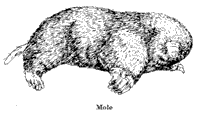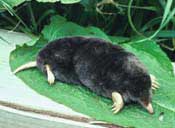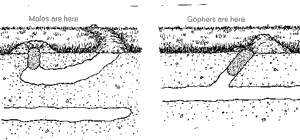What Mole Looks Like
 |
There are several kinds of moles in the US. The most widely distributed one is the Eastern mole whose range extends west as far as central Texas and overlaps the range of the hairy-tailed and starnose moles. California has its own mole.
Eastern moles spend most of their lives underground, feeding on earthworms and the larvae and adults of many kinds of insects. Depending on their sex and age, they vary in size from 4 to 9 inches long. Their low-slung, streamlined bodies are covered by a thick, velvety fur which is gray to blue-gray. Their large thick-clawed forepaws are their digging tools. Although moles have very poor eyesight, they have excellent hearing and sense of smell. They also are extremely sensitive to vibrations, which they detect through nerve endings in their snouts and their tails. They hold their tails erect during tunneling to monitor any overhead vibrations.
 |
Moles make two kinds of tunnels. Their warm weather surface tunnels are 1½ to 4 inches below the soil surface when insects and worms are near the surface and causing the most damage to plants in the yard. Some shallow tunneling is also from the male mole’s search for a mate. Cool weather tunnels 4 to 40 inches deep help them find insects and worms that have moved farther underground to escape frost. Moles never hibernate, so they must find food there.
Mole’s Feeding Habits
Moles are active 24 hours a day. Because they digest a complete meal roughly every 4 hours, they eat for 4 hours, then sleep the next 4 hours, and so on. They have specialized teeth--large pointed incisors--which are ideal for helping them catch and eat soft-bodied soil dwellers such as worms and grubs. Because of these teeth moles cannot chew and eat poisoned peanuts, gobs of chewing gum, and the multitude of hard objects that are often suggested as baits.
Also, moles are carnivores. They prefer mostly insects, grubs, centipedes, spiders, and earthworms they find in the soil. Stomach content studies reveal that most moles eat only small amounts of vegetable matter. They consume 70% to 100% of their own weight each day and, thus require large amounts of food. As soon as the supply of bugs and worms disappears from a yard, moles move on to new territories.
Distinguishing The Mole From Other Similar Animals
 |
Moles may be distinguished from meadow voles, gophers, and shrews by their naked, pointed nose that extends well in front of the mouth. Small eyes and ears are concealed by fur. Their spade like forefeet are wider than they are long. Discharged mounded soil and heaved runways are indicators of this pest's presence.
 |
Mole tunnels differ from gopher tunnels in one critical way. Moles push a short shaft straight up to the surface from their tunnels. As they push soil out through this hole, it forms a nearly circular mound, often with "ripple marks" or concentric circles marking layers of deposited dirt.
Gophers, on the other hand, construct a short inclined tunnel to the surface, and as they push the dirt out, they pile it only on one side of the hole. This offset soil mound is a helpful distinction in identifying gophers. They are more serious pests than moles.

